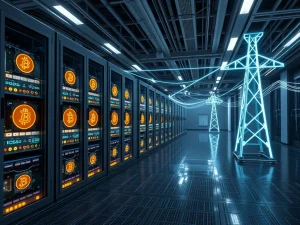Bitcoin Mining: Unlocking Profits and Power in 2025’s Dynamic Landscape

Are you curious about the intricate world of **Bitcoin mining**? As we navigate 2025, the landscape of digital gold extraction continues to evolve rapidly. This guide demystifies the complex processes, technological advancements, and economic forces shaping Bitcoin mining today. Understanding these elements is crucial for anyone interested in the backbone of the world’s leading cryptocurrency.
Understanding the Core of Bitcoin Mining
At its heart, **Bitcoin mining** serves as the vital mechanism that secures and operates the entire Bitcoin network. Essentially, miners gather pending transactions from the mempool. They then bundle these transactions into a ‘candidate block’. Following this, miners repeatedly perform hashing attempts. This process involves trial and error, aiming to produce a hash that meets the network’s current difficulty target. The first miner to discover a valid solution broadcasts their block across the network. Once other nodes verify it, that miner earns a reward. However, if another miner solves the block first, your result becomes a “stale block,” invalidating your work. Consequently, you must begin anew with a fresh set of transactions for the next block.
In 2025, the fixed block reward stands at 3.125 BTC. This figure reflects the significant reduction following the April 2024 **Bitcoin halving**. Furthermore, miners also earn transaction fees. These fees fluctuate considerably, depending heavily on network congestion. The competition within the mining sector remains exceptionally fierce. Therefore, the barrier to entry for new participants is quite high. Almost all successful miners now utilize specialized Application-Specific Integrated Circuit (ASIC) machines. Moreover, most miners join mining pools. This strategy helps stabilize their income by sharing rewards with other participants, mitigating the high variance of solo mining.
The Reality Behind the “Puzzle”
It is a common misconception that Bitcoin miners “solve complex cryptographic puzzles.” In reality, there is no actual puzzle to crack. Miners simply make trillions of guesses every second. They continue this process until one guess produces a hash below the network’s predetermined difficulty target. This brute-force computational effort is what constitutes the proof-of-work.
How a Bitcoin Block is Actually Found
The process of finding a block on the Bitcoin network is systematic. Here is a step-by-step breakdown:
- First, a miner constructs a candidate block. This block includes pending transactions from the mempool.
- Next, they add a special “coinbase transaction.” This transaction is distinct from the Coinbase exchange. It both mints new BTC and claims any associated transaction fees.
- The miner then repeatedly hashes the block’s header. They use the SHA-256 algorithm for this. Simultaneously, they adjust the nonce, a number used only once. The primary objective is to find a hash value that is lower than the network’s current difficulty target.
- Once a valid block is found, the miner immediately broadcasts it to the entire network.
- Other nodes independently verify its proof-of-work and all included transactions. They then add it to their local copy of the blockchain.
Occasionally, two miners might find valid blocks almost simultaneously. This can briefly split the blockchain into two versions. The network resolves this quickly. One branch accumulates more proof-of-work (PoW) and becomes the main chain. The other branch is then discarded as a “stale” block. This robust system ensures Bitcoin’s consensus always follows the chain with the greatest accumulated work. Consequently, it keeps forks short-lived and the ledger exceptionally resilient.
The Impact of the 2024 Bitcoin Halving on Rewards
The fourth **Bitcoin halving** occurred in April 2024. This pivotal event saw the block reward decrease significantly, falling from 6.25 BTC to 3.125 BTC. This 3.125 BTC is now the fixed reward every miner competes for. With approximately 144 blocks mined each day, the network issues roughly 450 new BTC daily. This calculation does not include additional transaction fees, which can significantly boost miner income.
Transaction Fees: The Unpredictable Wildcard
Transaction fees introduce an element of unpredictability into miner earnings. Around the April 2024 halving, Bitcoin experienced a substantial surge in network activity. This was largely triggered by the launch of Runes, a new token protocol. Runes flooded the mempool with transactions. For a brief period, transaction fees actually surpassed the 3.125 BTC block reward. Some blocks, remarkably, paid miners tens of BTC in fees alone. This represented a rare windfall compared to the usual baseline. However, these spikes were short-lived. By mid-2025, median fees had largely returned to normal levels as demand cooled. This pattern is quite familiar within the Bitcoin ecosystem. Whenever the mempool overflows, whether from new protocols, hype cycles, or major on-chain events, users eagerly outbid each other for space. They compete for inclusion within Bitcoin’s limited 1 MB-4 MB block window. Once the backlog clears, bidding wars subside, and fee revenue typically returns to its baseline levels.
Hashrate and Difficulty: The Pulse of Crypto Mining
**Hashrate** represents the total computing power dedicated to securing the Bitcoin network. It is a critical metric. Bitcoin maintains block times close to 10 minutes by dynamically adjusting mining difficulty. This adjustment occurs every 2,016 blocks, which is roughly every two weeks. This cyclical adjustment mechanism is fundamental to Bitcoin’s stability.
Here’s how this crucial cycle operates:
- When the hashrate increases, blocks are mined faster than the intended 10-minute target. This leads to the next adjustment raising the difficulty.
- Conversely, if the hashrate falls, blocks take longer to produce. In response, the network lowers the difficulty to compensate.
For miners, higher difficulty directly translates to earning fewer BTC for the same amount of computational work. Consequently, each difficulty retarget feels like an “earnings report.” It effectively resets revenue expectations for the subsequent two-week period. In 2025, both the **hashrate** and network difficulty are at record highs. New, more efficient ASIC fleets continually come online, pushing difficulty upward. This relentless competition forces older, less efficient rigs out of the market. Operators with high power costs are typically the first to shut down. They can only stay afloat by securing cheaper energy sources or benefiting from sudden, significant spikes in Bitcoin’s price and transaction fees. **Bitcoin mining** remains a constant technological and economic race. Only the most efficient setups truly survive when profit margins tighten.
Bitcoin’s Block Time Philosophy
Bitcoin’s 10-minute block time was meticulously designed as a compromise. It is short enough to allow for reasonably quick transaction confirmations. Yet, it is long enough to minimize the risk of simultaneous block discoveries and subsequent chain splits. This balance is crucial for network stability.
Advanced Mining Hardware in 2025
**Bitcoin mining** in 2025 emphasizes maximizing efficiency from every single watt of power. The industry has evolved significantly, moving far beyond simple hobby rigs. Modern mining operations are sophisticated industrial endeavors.
The Hardware Miners Use
At the core of nearly every contemporary mining farm are **ASICs**. These machines are purpose-built exclusively for Bitcoin’s SHA-256 algorithm. Their efficiency is measured in joules per terahash (J/TH). This metric indicates precisely how much energy is required to produce one unit of hashing power.
- Air-cooled units: These machines remain the workhorses of the industry. Models such as Bitmain’s S21 (17.5 J/TH) and MicroBT’s M60S (18.5 J/TH) dominate large-scale farms. High-end versions, like the Bitmain S21 XP, push efficiency even further, achieving around 13.5 J/TH.
- Hydro and immersion rigs: These represent the absolute cutting edge of **mining hardware**. Models like the S21 XP Hyd are rated near 12 J/TH. While they deliver top-tier performance, they demand specialized liquid-cooling systems. This adds both significant cost and operational complexity to a mining setup.
Cutting-Edge Cooling Approaches
Cooling has become a defining factor in optimizing large-scale mining operations:
- Air cooling: This is the cheapest and easiest method to deploy. However, it is inherently noisy and less power-dense, meaning it cannot cool as many machines in a given space.
- Immersion cooling: This advanced technique submerges rigs in dielectric fluid. It significantly boosts uptime and enhances overclocking potential. Large farms, such as Riot Platforms’ Rockdale facility, dedicate entire halls to this highly efficient setup.
- Hydro cooling: This involves closed-loop water systems built directly into the machines. It offers the highest efficiency but requires major infrastructure investment and careful maintenance.
Strategic Fleet Management
Mining economics can fluctuate dramatically week to week. Therefore, operators must adapt their fleets strategically. This involves both hardware choices and sophisticated firmware tuning:
- Low-power (underclocking): This strategy reduces output but significantly boosts efficiency. It is ideal when Bitcoin’s hashprice (revenue per unit of compute) is weak, helping to conserve energy costs.
- Overclocking: This approach trades efficiency for higher throughput. It is typically employed when BTC’s price or transaction fees surge, maximizing short-term revenue.
The golden rule in 2025 is clear: efficiency matters more than raw power. This holds true unless you possess access to ultra-cheap, highly reliable electricity. Such access can sometimes justify higher power consumption despite lower efficiency.
Mining Pools, Payouts, and Hashprice
Virtually all miners today point their machines to mining pools. These pools aggregate **hashrate** from thousands of individual participants. Pools are essential because they stabilize earnings. Instead of waiting to personally “win” a block, miners receive steady payouts based on their contributed share of the pool’s total hashing power. A handful of major pools, including Foundry USA, AntPool, F2Pool, and ViaBTC, collectively dominate the network. Their activity is easily trackable on live dashboards, which display which pool mined the latest block.
How Mining Pools Pay
Pools offer various payment models to distribute rewards:
- Pay-per-share (PPS) and Full Pay-per-Share (FPPS): These models offer highly predictable payouts for every share submitted. FPPS specifically includes an estimate of transaction fees in the payout, providing more comprehensive compensation.
- Pay-per-last-N-shares (PPLNS): This model is riskier. Rewards only materialize when the pool successfully finds blocks. While it carries higher variance, it can sometimes yield better returns during periods of high pool success.
The choice between these models often depends on a miner’s preference. Do they prefer steady cash flow (PPS/FPPS) or can they tolerate volatility for potential upside (PPLNS)?
Hashprice: The Miner’s Key Metric
Miner income is typically measured as **hashprice**. This metric represents the USD earned per petahash of hashrate per day. Hashprice generally rises with Bitcoin’s price and increasing transaction fees. Conversely, it declines as network difficulty increases. As of October 2025, the spot hashprice hovered around $51 per petahash per second per day. Break-even levels for miners vary widely. They depend heavily on machine efficiency and, crucially, electricity cost. This explains why miners with access to cheap or flexible power deals tend to survive market downturns more effectively.
Hedging in Bitcoin Mining
Interestingly, **Bitcoin mining** operators often employ hedging strategies, much like traditional energy companies. By utilizing tools such as hashrate forwards and fixed-payout contracts, they can lock in future revenue. This strategy helps them mitigate the inherent volatility of hashprice, bringing a degree of financial stability to their operations.
Energy and Geography: The Cost of Crypto Mining Energy
Energy costs, local grid policies, and geographical location are paramount. These factors ultimately determine which miners remain profitable and which ones are forced out of the market. Access to affordable and stable power is arguably the single most important factor for long-term success in **crypto mining energy**.
How Much Energy Does Bitcoin Use?
Estimates for Bitcoin’s energy consumption vary, depending on the source. In May 2025, Digiconomist estimated Bitcoin’s annualized electricity consumption at approximately 190 terawatt-hours. This figure is comparable to the yearly power usage of a mid-sized country like Poland or Thailand. Other estimates, including data from the Cambridge Bitcoin Electricity Consumption Index, place Bitcoin’s share of global electricity use at roughly 0.8%. In the United States, government data suggests that crypto mining accounts for between 0.6% and 2.3% of national power demand. These figures highlight the significant, yet often debated, energy footprint of the network.
Miners as Flexible Power Users
It is also important to recognize that miners often function as flexible loads on electrical grids. In regions like Texas, for instance, the Electric Reliability Council of Texas (ERCOT) market actively pays miners to power down their operations during periods of peak demand. Riot Platforms, a major mining company, disclosed that in August 2023, these demand-response credits were worth the equivalent of 1,136 BTC. Of course, such interruptible power deals can significantly alter the economics of mining, providing a crucial revenue stream and contributing to grid stability.
Where the Machines Are Located
Following China’s ban on **crypto mining energy** in 2021, a large portion of the displaced capacity relocated. It migrated to regions boasting abundant and often cheaper energy resources. Texas emerged as a significant focal point for these operations. Canadian provinces with ample hydroelectric capacity and natural gas reserves also attracted substantial deployments. By 2025, public mining companies were operating an estimated 7.4 gigawatts of capacity across the US and Canada. The deciding factors for these locations are straightforward: cheap and stable power, favorable regulatory terms, and grid programs that incentivize miners to act as a flexible load by curtailing operations during peak demand. These strategic decisions are crucial for long-term profitability and sustainability.
The Future Outlook for Bitcoin Mining in 2025 and Beyond
The world of **Bitcoin mining** in 2025 is defined by constant innovation and fierce competition. Miners face the dual challenge of declining block rewards due to the **Bitcoin halving** and increasing network difficulty driven by technological advancements. Success hinges on securing the most efficient **mining hardware** and access to low-cost, flexible **crypto mining energy**. As the network matures, miners will continue to play a critical role, not only in securing transactions but also in optimizing energy grids and driving innovation in sustainable computing. The relentless pursuit of efficiency and strategic partnerships will undoubtedly shape the future of this foundational industry.









